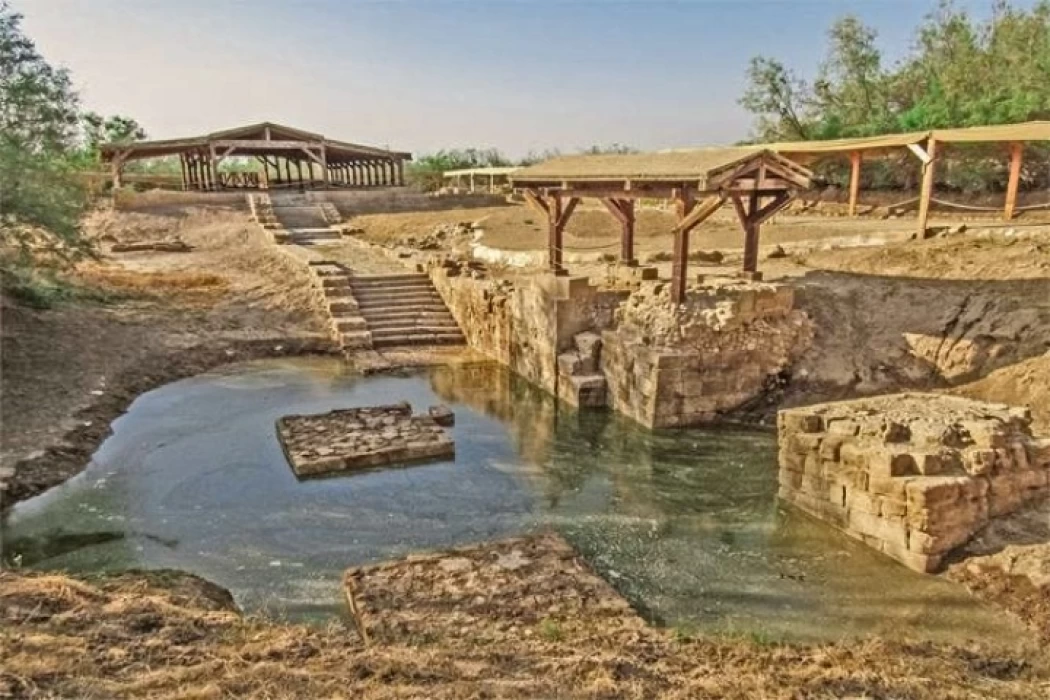
Baptism Site - Bethany Beyond the Jordan
Baptism Site - Bethany Beyond the Jordan
Perhaps the most prominent Christian site in Jordan is what is called “Al-Maghtas,” where Jesus Christ was baptized. The site of the baptism has been a subject of question among Christians since the first generations, where Jesus was baptized in the river, and determining the location was difficult, but the tradition that has been passed down since ancient times, and the data of the Holy Bible, point to several things from which Christians have concluded that John baptized Jesus Christ on the eastern bank of the river, at the point where the Roman road meets the river. Also, the archaeological excavations that have been conducted in recent years along the “Wadi Al-Kharrar” since 1996, have proven the location of Al-Maghtas east of the Jordan River.
In the late fifth century, Emperor Anastasius I (491-518) wanted to commemorate the baptism of Jesus Christ in the Jordan River, so he built a church on the eastern bank of the river, above arches, so that the church would remain safe from the river floods in the winter season and the melting of the snows of Mount Hermon. A staircase connected the church to the river water, where pilgrims would descend to bathe and receive blessings, and carry river water with them to their countries. He also built a column in the middle of the river topped with a cross.
After him, Emperor Justinian (517-565) also took an interest in this church and restored it. Nearby, from the eastern side of the river, a stream flowed about three kilometers between the hills before returning and pouring into the river from which it emerged. While conducting the archaeological excavations in Jordan in 1997, a number of age-old archaeological sites have been discovered that are connected to the very spot where John the Baptist performed the baptism, and which Jesus Christ was also baptized in. This series of sites lies in the Wadi al-Kharrar, to the east of the River Jordan.
This archaeological site, located nine kilometers north of the Dead Sea, includes two main archaeological areas: Tell al-Kharrar, known as the “Tel of Mar Elias” or “Prophet Elijah,” and the area of the churches of “John the Baptist” near the Jordan River. The site is characterized by ruins dating back to the Roman and Byzantine eras, such as churches, small temples, monasteries, caves that were used as shelters for hermits, as well as water pools designated for baptism.
The site of the Baptism Site includes five pools: the first is located on the lower western slope of the hill and dates back to the Roman era, another is located on the top of the northern end of Tell al-Kharrar, a southern pool that is rectangular in shape and has an internal staircase on the eastern side and four steps extending along the width of the pool, and two square pools that date back to the same Roman period. The square carved stones were added in later periods, and were perhaps used as a staircase to descend to the pool. The water reaches the pools via channels covered with arches.
In 2011, the senior dignitaries of the Christian churches of Jordan and their representatives attended a common meeting in which they endorsed that every discovery and every piece of evidence further confirms the Baptism Site located east of the Jordan River, and the positions of the remaining representatives of the church were also firmly in favor of the baptism site of Jesus Christ located to the east of the Jordan river, and not to the west of it.
The baptism site was among places that Pope Francis explored on May 24, 2014, during his trip to Jordan, which was hosted by King Abdullah II, his wife Queen Rania and other officials. He toured the site in a small convertible driven by King Abdullah. The late Pope John Paul II had visited the site before him, and declared it a place of Christian pilgrimage in the world, along with four other Jordanian sites. Jordan opened the “Baptism Site” as a tourist center in 2002.
The Baptism Site receives thousands of visitors and pilgrims from various churches and Christian sects. In 2017, His Beatitude Patriarch-Cardinal Mar Bechara Boutros Al-Rahi allowed the members of the Maronite Church residing in Lebanon and spread throughout the world to grant their children the sacrament of baptism at the Baptism Site in Jordan.














